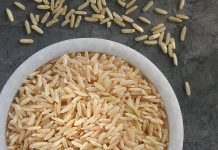The best steak I have ever had was at a friend’s house. It could not compare to any restaurant I have ever been to and I had definitely never made a steak like that before.
So, what was the secret? Why was this steak so mouth-wateringly delicious? The answer – a good steak marinade.
Let me walk you through what my friend taught me.
Steak Marinade Basics
A good cut of steak doesn’t need much, maybe a little butter, salt and pepper, garlic if you’re feeling wild.
Steaks cuts that do not need a marinade:
- Tomahawk Steak
- Filet Mignon
- New York Strip Steak
- T-Bone Steak
Steak cuts that should have a marinade:
- Flank Steak
- Skirt Steak
- Sirloin Steak
- Kabobs
A lesser quality cut of steak is not a bad cut, it just might not have as much consolidated flavor and is in need of a good tasty marinade.
What to Put in Your Marinade
There are four basic flavor profiles that every steak marinade needs to hit; Salt, oil, acidity, and a fresh herb.
Soy sauce, olive oil, orange zest, and parsley. Sea salt, butter, lemon juice, and garlic. Worcestershire sauce, butter, lemon juice, and Italian seasoning.
Any combination of these flavor profiles will work well together. If all else fails, you can never go wrong with butter, salt, pepper, and garlic.
Salt
Different forms of salt for your steak will include typical table salt, sea salt, and pink Himalayan salt. Soy sauce, Worcestershire sauce, and flake salt are also good options. If you’re feeling adventurous you could use fish sauce, anchovies, or fermented vegetables such as kimchi to add some salty flavor to your steak.
Oil or Fat
Butter and olive oil are the classic fats to use in any type of marinade. You can use avocado oil, vegetable oil, coconut oil, or sesame oil. Any type of oil or fat that can be melted and absorbed into the meat can be used to marinate the steak.
Acid
Acidic fruits are the ideal way to add acidity to your marinade. Lemon, lime, oranges, and blood orange are the most common forms of acidic fruits to add to your steak marinade.
You can also use vinegar to add some acidity to your marinade. Any kind of wine, balsamic vinegar, or tomatoes are great to add acidity to your steak marinade.
Herbs
Parsley, rosemary, oregano, tarragon, thyme, and bay leaves are the best herbs to add to your steak. Although any fresh herbs that add a touch of color will accompany your steak quite nicely.
You should always add garlic to your steak, and to every meal you ever make. Ginger is also an interesting herb to add to your steak marinade if you are going for an Asian vibe for your meal.
How Long to Marinade
You should always allow for an overnight marinade for your steak. In a pinch, you can marinate your steak for half an hour, but the longer you marinade any meat the better it will taste.
A vacuum seal bag will always result in the best absorption of your marinade.
How to Cook the Perfect Steak
Traditionally, they say to sear your steak before you put it in the oven. But, hear me out: reverse searing a steak.
The USDA recommends that you cook your beef to an internal temperature of 160°F. My personal recommendation is that you serve it bleeding… okay maybe not. The perfect steak, in my opinion, is a medium-rare, cooked to 130°F.
Bake your steak on a baking sheet lined with aluminum foil until it reaches your desired internal temperature. Preheat your oven to 275°F and check your steak every 5 minutes after the first 20 minutes to make sure it doesn’t go above your desired temperature.
Once your desired temperature is achieved, sear your steak in a frying pan on high heat for three minutes on each side.
In order for your steak not to dry out, add a little butter or olive oil while searing.
The thicker your cut of meat the better your reverse searing results will be. Try to pick a cut of meat that is one inch to one and a half-inch thick.
Fixing Overcooked Steak
If your steak is chewy, you overcooked the cut of meat. The only way to resurrect this is to chop it up into tiny pieces and make it into a taco.
Cooking your steak to an internal temperature of above 165°F will result in a sad, chewy, tasteless hunk of meat.
Sides For Your Steak
The best sides to add to your steak are potatoes, in any form. Mashed potatoes, roasted, it doesn’t matter. Mashed potatoes are currently my family favorite, and I always add cream cheese to elevate the flavor. Potatoes are always the perfect side for your steak.
Finally, you should always add a green vegetable like asparagus, broccoli, or Brussel sprouts to complete your meal.
Let it Rest
It is pertinent to let your steak rest five to ten minutes before cutting it into your steak. This is important because this way the juices will stay inside your steak and your steak won’t dry out.
After Dinner Plans
To achieve the best steak marinade, make sure you hit all the flavor profiles and be sure to reverse sear your steak. Trust me on this one.
After you have made the perfect steak and you have finished with dinner and had dessert, don’t forget to read more posts on our site. Check out articles about fashion, home improvement, travel, health, business, and more.




























































